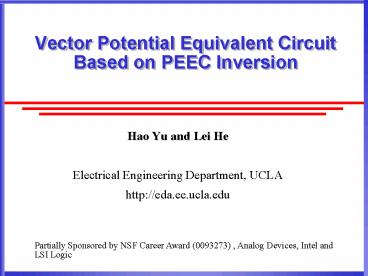Vector Potential Equivalent Circuit Based on PEEC Inversion
1 / 28
Title:
Vector Potential Equivalent Circuit Based on PEEC Inversion
Description:
Need to extend SPICE to simulate K-element [Ji: DAC'01] Windowing ... Major computing effort is inversion of inductance matrix. LU/Cholesky factorization ... –
Number of Views:95
Avg rating:3.0/5.0
Title: Vector Potential Equivalent Circuit Based on PEEC Inversion
1
Vector Potential Equivalent Circuit Based on
PEEC Inversion
- Hao Yu and Lei He
- Electrical Engineering Department, UCLA
- http//eda.ee.ucla.edu
Partially Sponsored by NSF Career Award (0093273)
, Analog Devices, Intel and LSI Logic
2
Outline
- Introduction
- Vector Potential Equivalent Circuit Model
- VPEC Property and Sparsification
- Conclusions and Future Work
3
Interconnect Model
- de facto PEEC model is expensive
- Accurate model needs detailed discretization of
conductors - Distributed RLC circuit has coupling inductance
between any two segments
- Total 3,278,080 elements for 128b bus with 20
segments per line - 162M storage of SPICE netlist
4
Challenge of Inductance Sparisification
- Partial inductance matrix L is not diagonal
dominant - Direct truncation results loss of passivity
- Existing passivity-guaranteed sparsification
methods lack accuracy or theoretical
justification - Returned-loop ShepardTCAD00
- Shift-truncation (shell) KrauterICCAD95,
Beattie TCAD01 - K-element DevganICCAD00, Ji DAC01
- Localized VPEC PacelliICCAD02
5
K-Element Method
- Need to extend SPICE to simulate K-element Ji
DAC01
6
Contribution of Our Paper
- Derive inversion based VPEC model from first
principles - Replace inductances with effective resistances
- Develop closed-form formula for effective
resistances - Enable direct and faster simulation in SPICE
- Prove that circuit matrix in VPEC model is
strictly diagonal dominant and hence passive - Enable various passivity preserved sparsifications
7
Outline
- Introduction
- Vector Potential Equivalent Circuit Model
- VPEC Property and Sparsification
- Conclusions and Future Work
- VPEC circuit model
- Inversion based VPEC
- Accuracy comparison
8
Vector Potential Equations for Inductive Effect
- Vector potential for filament i
ith Filament
- Integral equation for inductive effect
9
VPEC Circuit Model
10
VPEC Circuit Model
11
VPEC Circuit Model
12
Recap of VPEC Circuit Model
- Inherit resistances and capacitances from PEEC
- Inductances are modeled by
- Effective resistances
- Controlled current/voltage sources
- Unit self-inductance
- Much fewer reactive elements
- leads to faster SPICE simulation
13
Comparison with Localized VPEC
- Our solution
- Solution in localized VPEC PacelliICCAD02
(1) It is not accurate to consider only adjacent
filaments
(2) There is no efficient and closed-form formula
solution to calculate effective resistances
14
Introduction of G-Element
15
Closed-form Formula for Effective Resistance
- Major computing effort is inversion of
inductance matrix - LU/Cholesky factorization
- GMRES/GCR iteration (with volume decomposition)
Inversion Based VPEC
16
Interconnect Analysis Based on VPEC
- Calculate PEEC elements via either formula or
FastHenry/FastCap - Invert L matrix
- 3. Generate full VPEC including effective
resistances, current and voltage sources. - 4. Sparsify full VPEC using numerical or
geometrical truncations - 5. Directly simulate in SPICE
17
Spice Waveform Comparison
Full PEEC vs. full VPEC vs. localized VPEC
- Full VPEC is as accurate as Full PEEC
- Localized VPEC model is not accurate
18
Spiral Inductor
Non-bus Structure Three-turn single layer
on-chip spiral inductor
- Full VPEC model is accurate and can be applied
for general layout
19
Outline
- Introduction
- Vector Potential Equivalent Circuit Model
- VPEC Property and Sparsification
- Conclusions and Future Work
20
Property of VPEC Circuit Matrix
- Main Theorem
- The circuit matrix is strictly
diagonal-dominant and positive-definite
Corollary The VPEC model is still passive
after truncation
21
Numerical Sparsification
22
Truncation Threshold
128-bit bus with one segment per line
- Supply voltage is 1V
- VPEC runtime includes the LU inversion
- Full VPEC model is as accurate as full PEEC model
but yet faster - Increased truncation ratio leads to reduced
runtime and accuracy
23
Waveforms Comparison
- Full VPEC is as accurate as full PEEC
- Sparsified VPEC has high accuracy for up to
35.7 sparsification
24
Geometry Based Sparsification - Windowed
For the geometry of aligned bus line
25
Geometry Based Sparsification - Normalized
- Normalized VPEC
- normalized aligned coupling
26
Geometrical Sparsification Results
32-bit bus with 8 segment per line
- Decreased window size leads to reduced runtime
and accuracy - Windowed VPEC has high accuracy for window size
as small as (16,2) - Normalized model is still efficient with bounded
error
27
Runtime Scaling
- Circuit one segment per line for buses
- The runtime grows much faster for full PEEC than
for full VPEC - full PEEC is 47x faster for 256-bit bus due to
reduced number of reactive elements - Sparsified VPEC reduces runtime by 1000x with
bounded error for large scale interconnects
28
Conclusions and Future Work
- Derived inversion based VPEC from first principle
- Shown that Full VPEC has the same accuracy as
full PEEC but faster - Proved that VPEC model remains passive after
truncation
- To work on
- Fast iteration algorithms for inversion of L
- Model-order-reduction for VPEC































